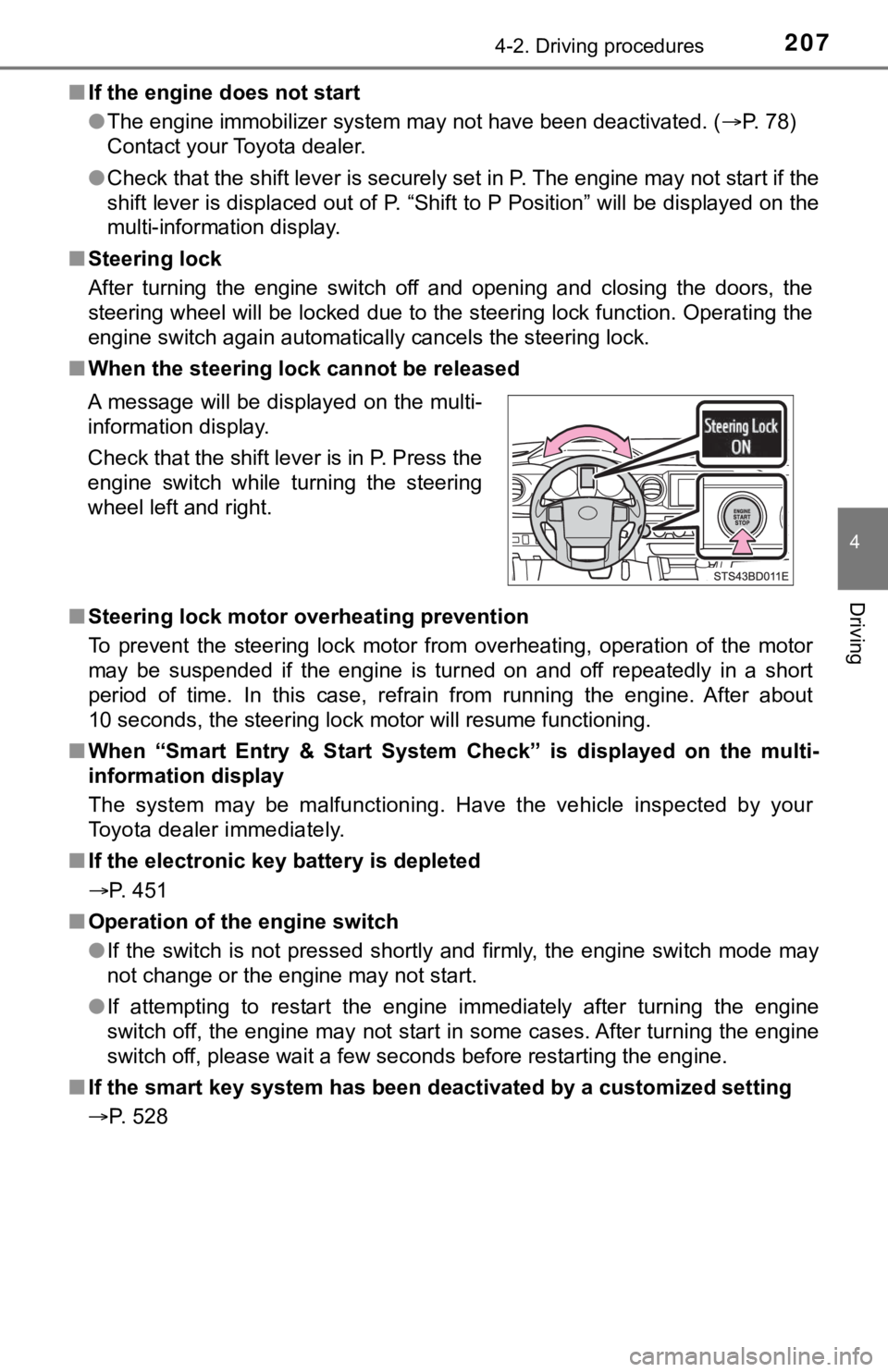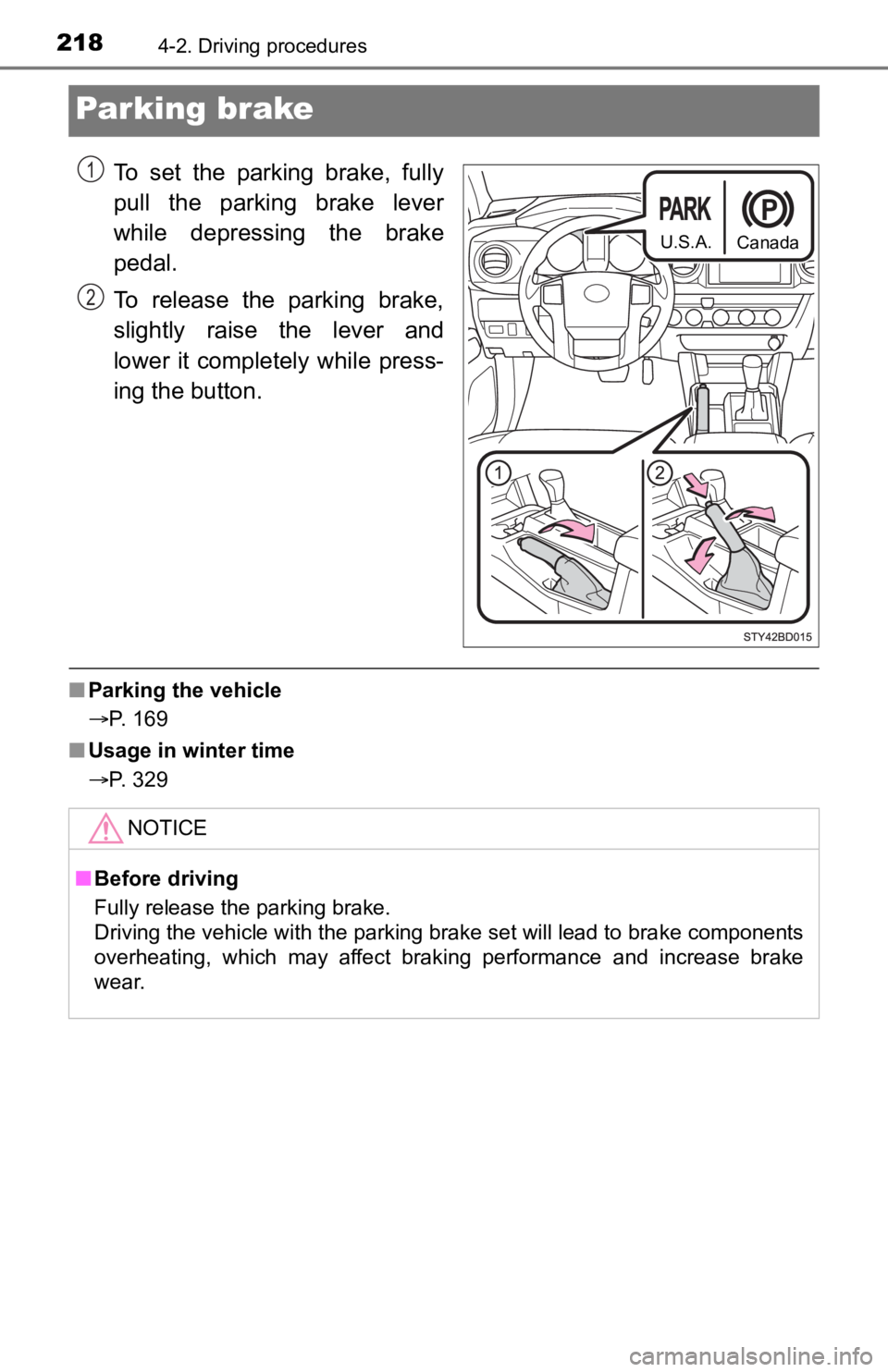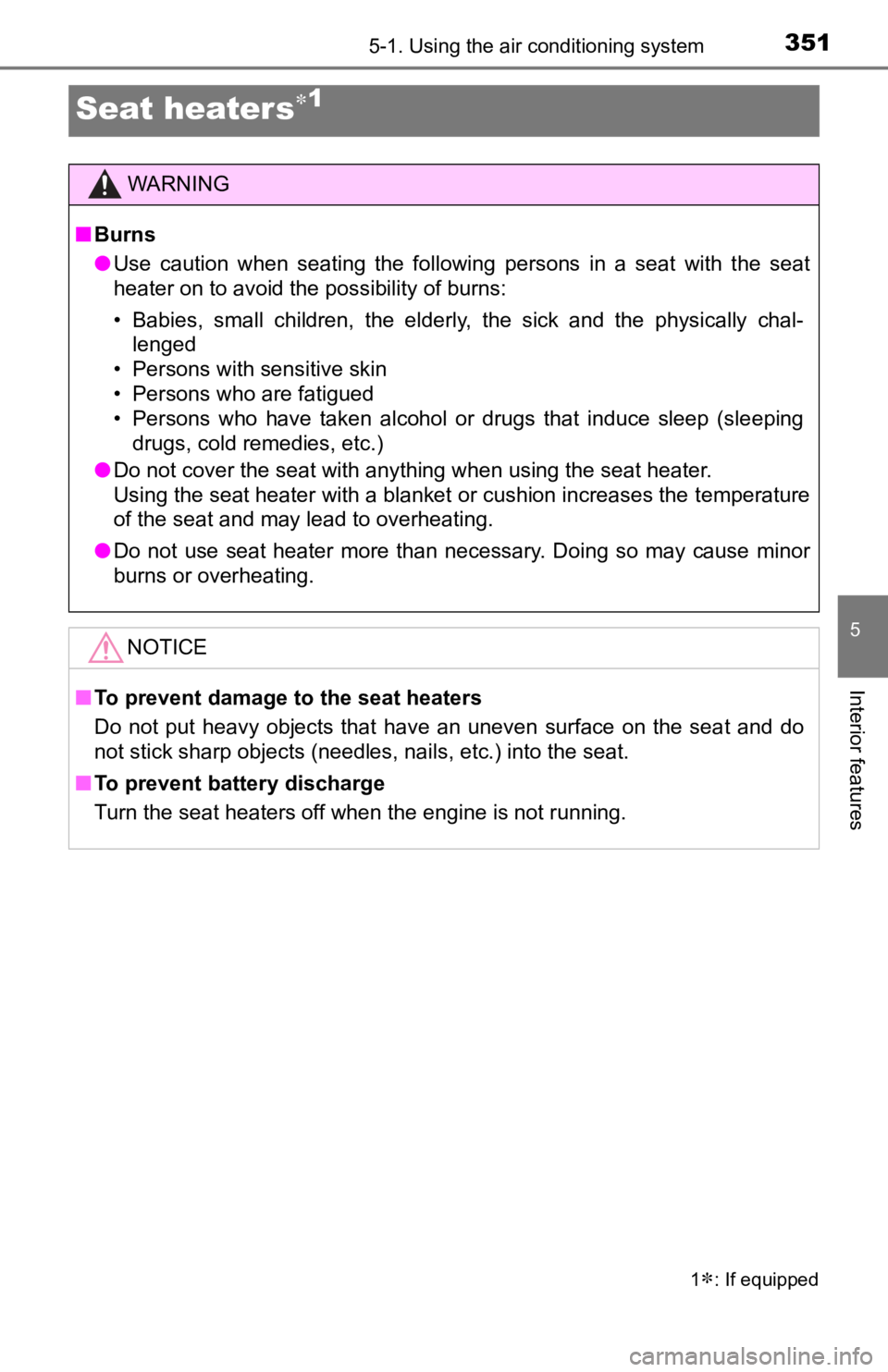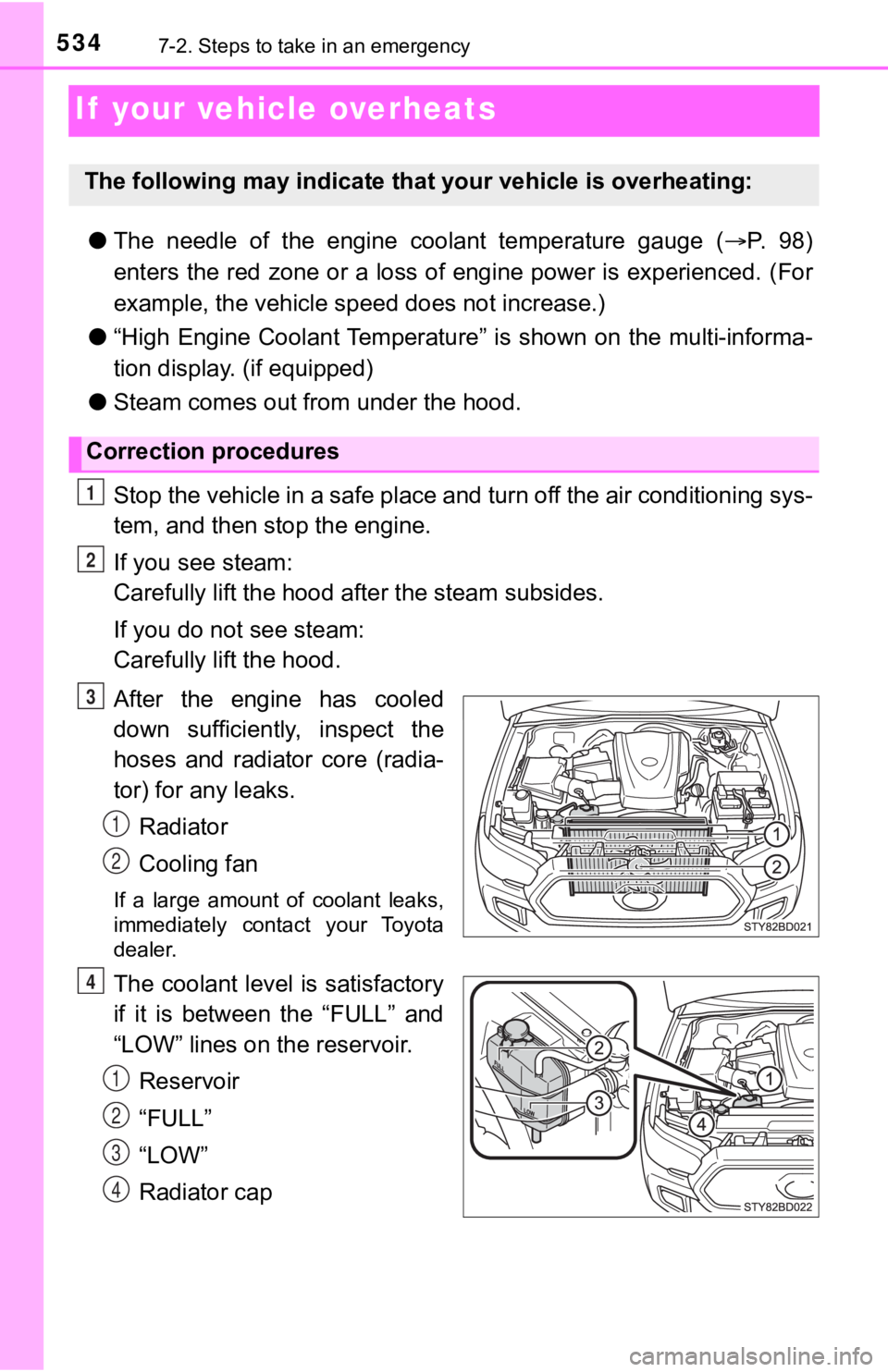overheating TOYOTA TACOMA 2022 Owners Manual
[x] Cancel search | Manufacturer: TOYOTA, Model Year: 2022, Model line: TACOMA, Model: TOYOTA TACOMA 2022Pages: 616, PDF Size: 12.92 MB
Page 101 of 616

1012. Instrument cluster
2
Instrument cluster
WARNING
■The information display at low temperatures
Allow the interior of the vehicle to warm up before using the liquid crystal
information display. At extremely low temperatures, the information display
monitor may respond slowly, and display changes may be delayed.
For example, there is a lag between the driver’s shifting and the new gear
number appearing on the display. This lag could cause the drive r to down-
shift again, causing rapid and excessive engine braking and pos sibly an
accident resulting in personal death or injury.
NOTICE
■ To prevent damage to the engine and its components
● Do not let the indicator needle of the tachometer enter the red zone, which
indicates the maximum engine speed.
● The engine may be overheating if the engine coolant temperature gauge is
in the red zone (H). In this case, immediately stop the vehicle in a safe
place, and check the engine after it has cooled completely. ( P. 534)
Page 175 of 616

1754-1. Before driving
4
Driving
WARNING
●Do not leave a door or window open if the curved glass is coated with a
metallized film such as a silver-colored one. Reflected sunligh t may cause
the glass to act as a lens, causing a fire.
● On vehicles with an automatic transmission, always apply the parking
brake, shift the shift lever to P, stop the engine and lock the vehicle.
Do not leave the vehicle unattended while the engine is running .
If the vehicle is parked with the shift lever in P but the park ing brake is not
set, the vehicle may start to move, possibly leading to an accident.
● Do not touch the exhaust pipes while the engine is running or i mmediately
after turning the engine off.
Doing so may cause burns.
■ When taking a nap in the vehicle
Always turn the engine off. Otherwise, if you accidentally move the shift
lever or depress the accelerator pedal, this could cause an acc ident or fire
due to engine overheating. Additionally, if the vehicle is parked in a poorly
ventilated area, exhaust gases may collect and enter the vehicl e, leading to
death or a serious health hazard.
■ When braking
● When the brakes are wet, drive more cautiously.
Braking distance increases when the brakes are wet, and this may cause
one side of the vehicle to brake differently than the other side. Also, the
parking brake may not securely hold the vehicle.
● If the brake booster device does not operate, do not follow oth er vehicles
closely and avoid hills or shar p turns that require braking.
In this case, braking is still possible, but the brake pedal should be
depressed more firmly than usual. Also, the braking distance will increase.
Have your brakes fixed immediately.
● Do not pump the brake pedal if the engine stalls.
Each push on the brake pedal uses up the reserve for the power-assisted
brakes.
● The brake system consists of 2 individual hydraulic systems; if one of the
systems fails, the other will still operate. In this case, the brake pedal
should be depressed more firmly than usual and the braking dist ance will
increase. Have your brakes fixed immediately.
■ If the vehicle becomes stuck
Do not spin the wheels excessively when any of the tires is up in the air, or
the vehicle is stuck in sand, mud, etc. This may damage the driveline com-
ponents or propel the vehicle forward or backward, causing an accident.
Page 194 of 616

1944-1. Before driving
●Slow down before making a turn, in crosswinds, on wet or slippe ry
surfaces, etc.
Increasing vehicle speed can destabilize the trailer.
● Take care when passing other vehicles. Passing requires consider-
able distance. After passing a vehicle, do not forget the lengt h of
your trailer, and be sure you have plenty of room before changi ng
lanes.
● Vehicles with an automatic transmission: To maintain engine bra k-
ing efficiency and charging system performance when using engin e
braking, do not use the transmission in D. If in the S mode, th e
transmission shift range posit ion must be in 5 or lower.
● Vehicles with a manual transmiss ion: To maintain engine braking
efficiency and charging system performance when using engine
braking, do not use the sixth gear.
● Instability happens more frequently when descending steep or lo ng
downhill grades. Before descending, slow down and downshift. Do
not make sudden downshifts while descending steep or long down-
hill grades.
● Avoid holding the brake pedal down too long or applying the bra kes
too frequently. This could cause the brakes to overheat and result in
reduced braking efficiency.
● Due to the added load of the trailer, your vehicle’s engine may over-
heat on hot days (at temperatures over 85°F [30°C]) when drivin g
up a long or steep grade. If the engine coolant temperature gau ge
indicates overheating, immediately turn off the air conditionin g (if in
use), pull your vehicle off the road and stop in a safe spot.
( P. 534)
Page 207 of 616

2074-2. Driving procedures
4
Driving
■If the engine does not start
●The engine immobilizer system may not have been deactivated. ( P. 78)
Contact your Toyota dealer.
● Check that the shift lever is securely set in P. The engine may not start if the
shift lever is displaced out of P. “Shift to P Position” will b e displayed on the
multi-information display.
■ Steering lock
After turning the engine switch off and opening and closing the doors, the
steering wheel will be locked due to the steering lock function . Operating the
engine switch again automatically cancels the steering lock.
■ When the steering lock cannot be released
■ Steering lock motor overheating prevention
To prevent the steering lock motor from overheating, operation of the motor
may be suspended if the engine is turned on and off repeatedly in a short
period of time. In this case, refrain from running the engine. After about
10 seconds, the steering lock motor will resume functioning.
■ When “Smart Entry & Start System Check” is displayed on the multi-
information display
The system may be malfunctioning. Have the vehicle inspected by your
Toyota dealer immediately.
■ If the electronic key battery is depleted
P. 451
■ Operation of the engine switch
●If the switch is not pressed shortly and firmly, the engine swi tch mode may
not change or the engine may not start.
● If attempting to restart the engine immediately after turning t he engine
switch off, the engine may not start in some cases. After turni ng the engine
switch off, please wait a few seconds before restarting the eng ine.
■ If the smart key system has been d eactivated by a customized setting
P. 528 A message will be displayed on the multi-
information display.
Check that the shift lever is in P. Press the
engine switch while turning the steering
wheel left and right.
Page 218 of 616

2184-2. Driving procedures
Parking brake
To set the parking brake, fully
pull the parking brake lever
while depressing the brake
pedal.
To release the parking brake,
slightly raise the lever and
lower it completely while press-
ing the button.
■Parking the vehicle
P. 169
■ Usage in winter time
P. 329
U.S.A.
Canada
1
2
NOTICE
■Before driving
Fully release the parking brake.
Driving the vehicle with the parking brake set will lead to bra ke components
overheating, which may affect braking performance and increase brake
wear.
Page 319 of 616

3194-5. Using the driving support systems
4
Driving
■Automatic system cancelation
In the following situations, the buzzer will sound intermittently and Crawl Con-
trol will be canceled automatically. In this event, the Crawl C ontrol indicator
will flash and then goes off, and a message stating that Crawl Control has
been turned off will be displayed on the multi-information disp lay for several
seconds.
● When the shift lever is shifted to P or N
● When the front-wheel drive control switch is turned to “4H”
● When the driver’s door is opened
■ Function limitations
When the vehicle speed exceeds appr oximately 15 mph (25 km), engine con-
trol and brake control will stop temporarily. In this event, th e Crawl Control
indicator will flash.
■ When the Crawl Control system is operated continuously
● If Crawl Control is used continuously for a long time, the buzz er will sound, a
malfunction notification will be displayed on the multi-informa tion display,
the Crawl Control indicator goes off, and Crawl Control will be temporarily
inoperable as a result of the brake system overheating. In this event, stop
the vehicle immediately in a safe place, and allow the brake sy stem to cool
down sufficiently until the “TRAC OFF” indicator will goes off. (In the mean-
time, normal driving is possible.)
● If Crawl Control is used continuously for a long time, the buzz er will sound,
the system will be temporarily canceled, and a malfunction noti fication will
be displayed on the multi-information display as a result of th e automatic
transmission system overheating. Stop the vehicle in a safe pla ce until the
display goes off.
■ Sounds and vibrations caused by the Crawl Control system
● A sound may be heard from the engine compartment when the engin e is
started or just after the vehicle begins to move. This sound do es not indicate
that a malfunction has occurred in Crawl Control system.
● Either of the following conditions may occur when the Crawl Con trol system
is operating. None of these indicates that a malfunction has occurred.
• Vibrations may be felt through the vehicle body and steering.
• A motor sound may be heard after the vehicle comes to a stop.
■ When there is a malfunction in the system
Warning lights and/or warning messages will turn on. ( P. 489)
Page 351 of 616

3515-1. Using the air conditioning system
5
Interior features
Seat heaters1
1: If equipped
WARNING
■Burns
● Use caution when seating the following persons in a seat with t he seat
heater on to avoid the possibility of burns:
• Babies, small children, the elderly, the sick and the physically chal- lenged
• Persons with sensitive skin
• Persons who are fatigued
• Persons who have taken alcohol or drugs that induce sleep (sleeping drugs, cold remedies, etc.)
● Do not cover the seat with anything when using the seat heater.
Using the seat heater with a blanket or cushion increases the temperature
of the seat and may lead to overheating.
● Do not use seat heater more than necessary. Doing so may cause minor
burns or overheating.
NOTICE
■ To prevent damage to the seat heaters
Do not put heavy objects that have an uneven surface on the sea t and do
not stick sharp objects (needles, nails, etc.) into the seat.
■ To prevent battery discharge
Turn the seat heaters off when the engine is not running.
Page 534 of 616

5347-2. Steps to take in an emergency
If your vehicle overheats
●The needle of the engine coolant temperature gauge ( P. 9 8 )
enters the red zone or a loss of engine power is experienced. ( For
example, the vehicle speed does not increase.)
● “High Engine Coolant Temperature” is shown on the multi-informa-
tion display. (if equipped)
● Steam comes out f rom under the hood.
Stop the vehicle in a safe place and turn off the air condition ing sys-
tem, and then stop the engine.
If you see steam:
Carefully lift the hood after the steam subsides.
If you do not see steam:
Carefully lift the hood.
After the engine has cooled
down sufficiently, inspect the
hoses and radiator core (radia-
tor) for any leaks. Radiator
Cooling fan
If a large amount of coolant leaks,
immediately contact your Toyota
dealer.
The coolant level is satisfactory
if it is between the “FULL” and
“LOW” lines on the reservoir.Reservoir
“FULL”
“LOW”
Radiator cap
The following may indicate that your vehicle is overheating:
Correction procedures
1
2
3
1
2
4
1
2
3
4
Page 602 of 616

602Alphabetical index
Child safety ................................ 53Airbag precautions .................. 39
Battery precautions ............... 533
Child restraint system ............. 54
How your child should wear the seat belt ................. 32
Installing child restraints ......... 58
Moon roof precautions .......... 165
Power back window precautions ......................... 161
Power window lock switch .... 156
Power window precautions ... 158
Rear door child-protector ...... 123
Removed wireless remote control/electronic key
battery precautions ............. 453
Seat belt extender precautions ........................... 35
Seat belt precautions .............. 57
Seat heater precautions........ 351
Child-protectors....................... 123
Cleaning ........................... 402, 406 Aluminum wheels.................. 403
Exterior ................................. 402
Interior................................... 406
Seat belts .............................. 407
Clock
*
Compass .................................. 397
Condenser ................................ 425
Console box ............................. 358
Consumption screen ....... 103, 109
Cooling system ........................ 423 Capacity ................................ 547
Checking ............................... 423
Engine overheating ............... 534
Preparing and checking before winter....................... 328 Crawl Control ........................... 317
CRS ............................................. 54
Cruise control
Cruise control ....................... 279
Dynamic radar cruise control ................................ 265
Cup holders ............................. 359
Curtain shield airbags............... 37
Customizable features ............ 568
Daytime running light system.................................... 221
Deck hooks .............................. 367
Defogger Outside rear view
mirrors ........................ 340, 347
Windshield .................... 340, 347
Differential................................ 548
Dimensions .............................. 540
Dinghy towing.......................... 200
Display
Drive information .................. 103
Dynamic radar cruise control ................................ 265
LDA (Lane Departure Alert) ....... 257
Multi-information display ....... 102
Warning message................. 489
Do-it-yourself maintenance .... 415
Door lock Doors .................................... 119
Key ....................................... 119
Smart key system ................. 120
Wireless remote control ........ 119
D
Page 604 of 616

604Alphabetical index
Emergency flashers ................ 472
EngineCompartment ........................ 419
Engine switch................ 201, 204
Hood ..................................... 417
How to start the engine......................... 201, 204
Identification number ............ 543
If the engine will not start ...... 526
Ignition switch (engine switch) ........... 201, 204
Immobilizer system ................. 78
Overheating .......................... 534
Engine coolant ......................... 423 Capacity ................................ 547
Checking ............................... 423
Preparing and checking before winter....................... 328
Engine coolant temperature
gauge........................................ 98
Engine immobilizer system ...... 78
Engine oil ................................. 421 Capacity ................................ 545
Checking ............................... 421
Oil level warning message .... 492
Oil pressure warning message ............................. 490
Preparing and checking
before winter....................... 328
Engine switch (ignition switch)............. 201, 204
Engine switch light (ignition switch light) ............ 353
Event data recorder (EDR) ........ 11 Flat tire ..................................... 511
Floor mats .................................. 26
Fluid
Automatic transmission ........ 549
Brake .................................... 550
Power steering...................... 550
Washer ................................. 430
Fog lights ................................. 228 Replacing light bulbs ............ 463
Switch ................................... 228
Wattage ................................ 553
Four-wheel drive system ........ 302
Front passenger occupant classification system .............. 48
Front personal lights............... 354
Front seats ............................... 139 Adjustment............................ 139
Cleaning ............................... 406
Correct driving posture ........... 28
Head restraints ..................... 145
Seat heaters ......................... 351
Front side marker lights
Light switch ........................... 219
Replacing light bulbs ............ 461
Wattage ................................ 553
Front turn signal lights Replacing light bulbs ............ 462
Turn signal lever ................... 217
Wattage ................................ 553F